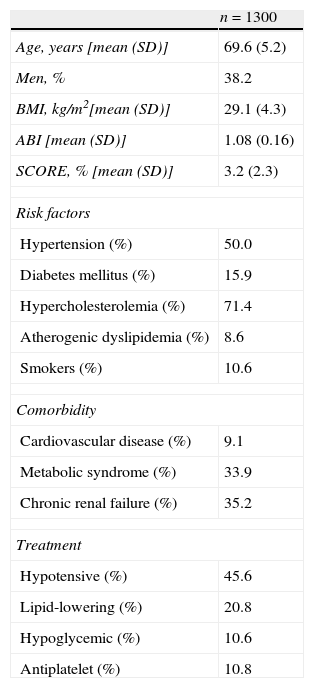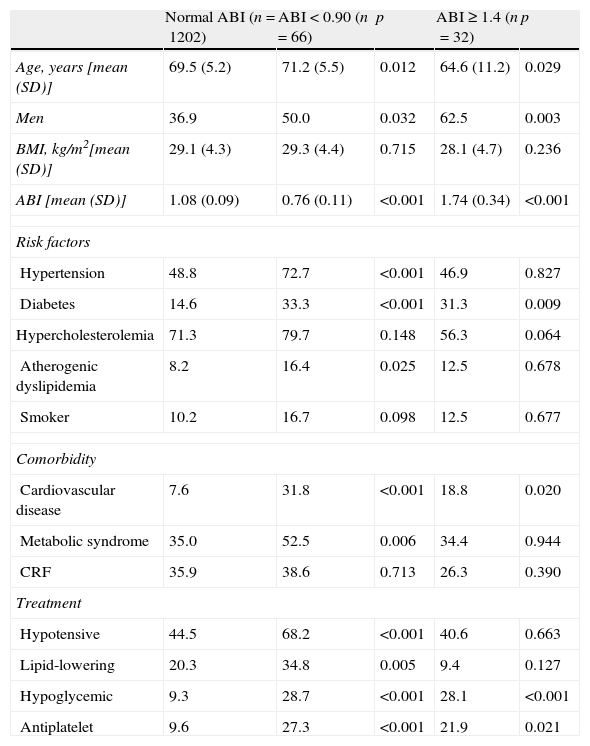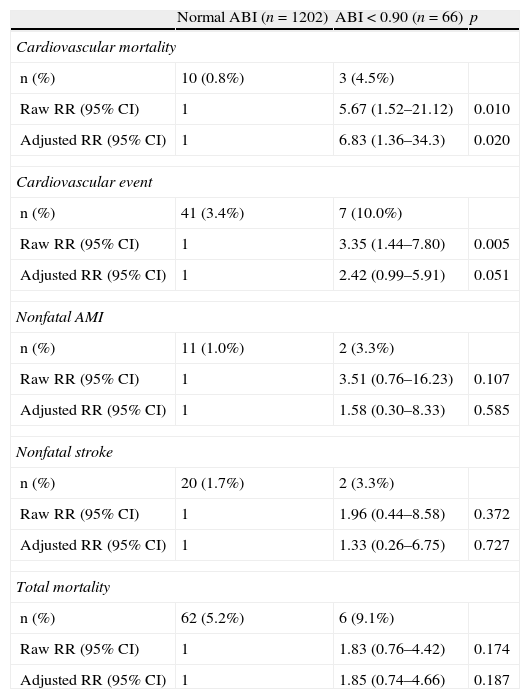Abnormal ankle-brachial index (ABI) is associated with a high risk of cardiovascular disease. This study has aimed to investigate the association between low ABI and risk of cardiovascular death in a general population attended in a primary care center.
Patients and methodsA total of 1361 volunteers aged between 60 and 79 years without any evidence of peripheral artery disease who attended a primary care center participated in the study. They underwent a complete physical examination, together with standard blood tests and ABI was determined. The participants were contacted by telephone 4 years later and asked about any cardiovascular problems for that period. Causes of death and hospitalization were confirmed in the medical records in the primary care center and/or hospital.
ResultsInformation was obtained about the clinical evolution of 1300 participants (mean age 69.9 years, 38.2% men). Mean follow-up was 49.8 months. There were 13 cardiovascular death and 49 major cardiovascular events. Low ABI (<0.9) was associated with a significant higher risk of cardiovascular death (adjusted relative risk 6.83; 95% confidence interval 1.36–34.30, P=0.020), and with a higher risk of major cardiovascular events (adjusted relative risk 2.42; 95% confidence interval 0.99–5.91, P=0.051). High or uncompressible ABI was not associated with higher cardiovascular risk.
ConclusionsA low ABI was associated with higher risk of cardiovascular death in the general population followed up in a primary care center.
Un índice tobillo-brazo (ITB) anormal se asocia con un elevado riesgo de enfermedad cardiovascular. El objetivo del estudio fue investigar la asociación entre un ITB bajo con el riesgo de muerte de causa cardiovascular en una población atendida en un centro de salud.
Pacientes y métodosParticiparon 1.361 voluntarios de entre 60 y 79 años sin enfermedad arterial periférica conocida, reclutados en una consulta de atención primaria. Se les hizo una historia clínica, una exploración física, un análisis de sangre y se les determinó el ITB. Cuatro años después se contactó con ellos y se les interrogó sobre problemas cardiovasculares acaecidos durante ese periodo. Las causas de los ingresos o de las muertes se confirmaron en las historias clínicas del centro de salud y/o del hospital de zona.
ResultadosSe consiguió información sobre la evolución clínica de 1.300 participantes (edad media 69,6 años; un 38,2% eran varones). El seguimiento medio fue de 49,8 meses. Hubo 13 muertes de causa cardiovascular y 49 eventos cardiovasculares mayores. Un ITB bajo basal (<0,9) se asoció con un significativo mayor riesgo de muerte cardiovascular (riesgo relativo ajustado 6,83; intervalo de confianza 95%: 1,36-34,30; p=0,020), así como con un mayor riesgo de eventos cardiovasculares (riesgo relativo ajustado 2,42; intervalo de confianza 95%: 0,99-5,91; p=0,051). El ITB alto (>1,4) o incompresible no se asoció con un mayor riesgo cardiovascular.
ConclusionesEn población general seguida en un centro de salud, un ITB bajo se asocia con un mayor riesgo de muerte cardiovascular.
Article
Diríjase desde aquí a la web de la >>>FESEMI<<< e inicie sesión mediante el formulario que se encuentra en la barra superior, pulsando sobre el candado.

Una vez autentificado, en la misma web de FESEMI, en el menú superior, elija la opción deseada.

>>>FESEMI<<<








